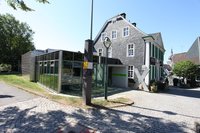Uferbefestigung am Fluss Mugnone (Nebenfluss des Arno) im Stadtteil Le Cure von Florenz. Auf dem Wehr Pescaia delle Cure steht ein sogenannter "Renaiolo", ein Arbeiter der aus dem Fluss Kies und Sand gewinnt, die für Bauarbeiten benötigt wurden. Er hält ein Sieb in der Hand, neben ihm liegt eine Schaufel. Am Ufer steht eine Person, die dem Mann zuschaut, daneben befindet sich ein Fuhrwerk mit einem Mann darauf. In der Ferne sieht man die Brücke Ponte alle Riffe. Links führt die Straße Via Giovanni Boccaccio am Ufer entlang.
en









